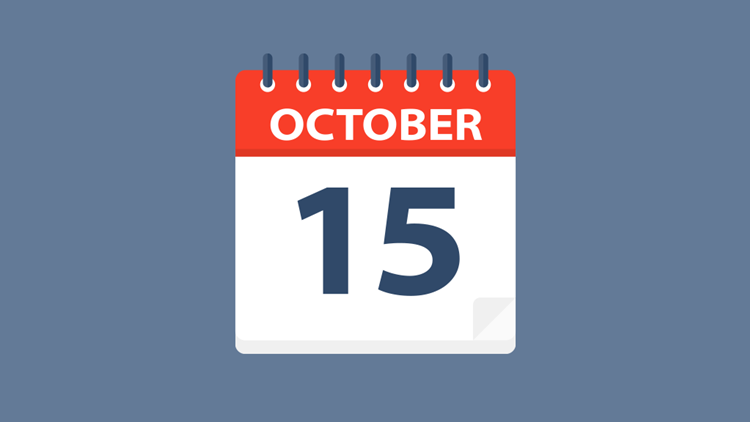
This time of year, filing our income taxes may not top the other concerns of the day. Fall weather, school days and football all tend to take center stage.
That said, we could all probably use a reminder that if a taxpayer filed an extension back in May, their income tax return is due in the hands of the Internal Revenue Service no later than October 15.
There was no extension, of course, for payment of any taxes due.
If a taxpayer is due a refund, good news: usually there’s no penalty for filing late. But those who wait too long to file and claim a refund could see that refund evaporate.
Taxpayers who haven’t filed for the 2020 tax year, didn’t get an extension and owe tax due are in the most vulnerable position; their best strategy is to file as soon as possible and pay any tax owed now to avoid additional penalties and interest.
For most, October 15 is the last day to file for the 2020 tax year, but some taxpayers have a little more time.
Members of the military and others who serve in a combat zone usually have 180 days after they leave the combat zone to file and pay any tax due.
Taxpayers with valid extensions and who live in a federally declared disaster area have filing options depending on the relief package issued by the IRS. Check the disaster relief page on IRS.gov for details.
The IRS suggests electronic payment options
Filers can schedule electronic tax payments right up to the October 15 due date. There are options available, including paying online, by phone, or using a mobile phone and the IRS2Go app.
The IRS says taxpayers who use a tax pro should ask to make their tax payments through an electronic funds withdrawal from a bank account. Another option is IRS DirectPay, which allows a taxpayers to pay online directly from a checking or savings account for free. Payments can also be scheduled up to a year in advance.
Another mobile-friendly option is the IRS2Go app, which has options including Direct Pay and credit or debit card payments on mobile devices.
The Electronic Federal Tax Payment System (EFTPS) is a tried-and-true electronic system that’s been in use for years. Taxpayers can pay online or by phone using the system’s Voice Response System.
The final option is to use a third-party payment processor that allows the taxpayer to pay with a credit or debit card or even a digital wallet; however, the processor charges a fee for this service.
Electronic transmission also works in the opposite direction—for refunds. Direct deposit is far safer and quicker than a paper check in the mail. Direct deposit can divvy a refund into as many as three different accounts—or even purchase U.S. Savings Bonds.
Some people may not have a bank account. These taxpayers can go online to the FDIC website or to the National Credit Union Association site for information on how to open an online bank or credit union account.
The Veterans Benefits Banking Program (VBBP) is available to veterans, giving them access to financial services at participating banks.
Looking for your tax information? Go online
Those who need information about their taxes—whether it’s needed to file or just to get a snapshot of their tax history—can go to their online account. Each online account includes:
- Adjusted Gross Income: This can be useful if using a different tax preparer this year.
- Economic Impact Payment amounts: Eligible individuals who did not receive the full amounts of both Economic Impact Payments may claim the Recovery Rebate Credit on their 2020 federal tax return. To claim the full amount, taxpayers will need to know the amounts of the Economic Impact Payments received. These amounts can be found on the Tax Records tab in online account.
- Estimated tax payment amounts: The total of any estimated tax payments made during the year or refunds applied as a credit can be found on the Account Balance tab in the online account, and a record of each payment appears under Payment Activity.
In addition, online account owners can view the amount owed for any past years, updated for the current calendar day; their payment history and any pending payments; payment plan details and digital copies of some IRS notices.
The online account also gives taxpayers the chance to approve or reject authorization requests from tax pros.
What are some other reasons to file?
Some taxpayers may have other reasons to file their 2020 income tax return other than just doing the right thing.
One reason is to sign up for a stimulus payment, if the taxpayer missed out on the first or second Economic Impact Payment (EIP).
Another reason is to change or update information needed to receive monthly advance Child Tax Credit payments. The IRS uses 2019 tax information for most recipients, but if a child was born during 2020, for example, the taxpayer may qualify for a larger credit.
In both cases, a 2020 tax return is needed to provide the IRS with the information it needs to help. And to file quicker and easier, the IRS is urging these taxpayers to file electronically.
For answers to a wide array of tax questions, consult the Interactive Tax Assistant (ITA), an online tax law resource. Tax payment options are explained at IRS.gov/payments and are available in several languages.
Source: IR-2021-189
